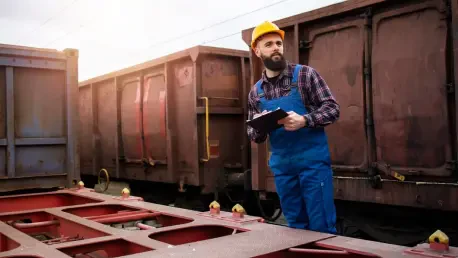Charting the Course of Rail Freight: A Market in Motion
Imagine a world where global trade moves seamlessly across continents, powered by a mode of transport that slashes carbon emissions and cuts costs, positioning rail freight at the forefront of this vision. Rail freight emerges as a linchpin of sustainable logistics in an era of escalating environmental scrutiny and booming e-commerce. With projections estimating the market to reach USD 431.4 billion by 2034 at a compound annual growth rate (CAGR) of 5.7%, this industry is not just growing—it’s transforming the backbone of global supply chains.
This analysis dives deep into the rail freight sector, exploring why it’s gaining traction as a preferred solution for moving bulk goods like coal, agricultural products, and industrial materials over vast distances. The purpose is to unpack the trends, challenges, and innovations driving this impressive growth, offering stakeholders a clear view of opportunities and hurdles ahead. As trade networks expand and green policies tighten, understanding these dynamics becomes critical for businesses and policymakers alike.
The following sections will dissect current market patterns, forecast future developments, and provide actionable insights for navigating this evolving landscape. From infrastructure investments to technological breakthroughs, the rail freight market offers a compelling case study in balancing efficiency with sustainability. This examination aims to equip readers with the knowledge to leverage the sector’s potential over the next decade.
Unpacking Market Trends and Projections
Sustainability: The Engine of Rail Freight Demand
Rail freight’s rise is closely tied to its environmental edge over road and air transport, emitting up to 75% less carbon per ton-mile compared to trucking. Amid global pushes for net-zero targets, companies and governments are increasingly turning to rail to meet stringent emissions regulations. This shift is particularly pronounced in Europe, where policies actively incentivize rail over more polluting alternatives for long-haul shipments.
Beyond its green credentials, rail freight benefits from growing corporate commitments to sustainable supply chains. Major industries, such as manufacturing and agriculture, are reevaluating logistics strategies to align with environmental goals, often finding rail to be the most viable option for bulk transport. However, the transition isn’t seamless—investments in electric locomotives and renewable energy integration are still needed to maximize these benefits.
A lingering challenge lies in convincing shippers to prioritize sustainability over speed. For time-sensitive goods, air and road often remain the default despite higher costs and emissions. Overcoming this mindset requires not only advocacy but also innovations that narrow the gap in delivery times, positioning rail as a truly competitive choice in a greener future.
E-Commerce Surge and Global Trade Expansion
The explosion of e-commerce has reshaped logistics, creating a surge in demand for efficient, large-scale freight solutions. Rail freight is stepping up, particularly for cross-border trade, as seen with China’s Belt and Road Initiative, which connects Asian and European markets through expansive rail networks. This infrastructure facilitates cost-effective movement of high-volume goods, a critical need as online retail continues to grow.
International trade agreements and economic corridors further amplify rail’s role, enabling it to handle the increasing flow of commodities and consumer products. Unlike road transport, rail offers scalability for massive shipments, reducing per-unit costs over long distances. Yet, the pressure for rapid delivery—a hallmark of e-commerce—poses a challenge, as rail historically lags in speed compared to trucks for last-mile logistics.
To address this, intermodal systems integrating rail with road transport are gaining traction, ensuring seamless transitions for faster end-to-end delivery. While geopolitical risks and trade disruptions could impact key routes, the overarching trend points to rail freight as a cornerstone of global commerce, provided it adapts to the pace of modern supply chains.
Infrastructure Investments and Regional Variations
Significant investments in rail infrastructure are fueling market growth, particularly in developed regions like North America and Europe, where high-speed freight corridors and digitized systems enhance operational efficiency. These advancements allow for quicker transit times and better cargo tracking, strengthening rail’s competitive position. Governments are also stepping in with funding to modernize aging networks, recognizing rail’s role in sustainable transport.
However, stark disparities exist across regions. Developing areas in Africa and parts of Asia often grapple with outdated tracks and limited capital, hindering their integration into global trade networks. These gaps result in inefficiencies, with some countries unable to capitalize on rail’s cost and environmental advantages due to poor connectivity or regulatory fragmentation.
Bridging these divides demands more than financial input—it requires coordinated policy frameworks and public-private partnerships. While some regions showcase success through strategic investments, others risk being left behind unless tailored solutions address local constraints. This uneven progress highlights the need for a nuanced approach to infrastructure development over the coming years.
Technological Innovations and Future Outlook
Automation and Digital Tools Reshaping Operations
The rail freight sector is on the brink of a technological revolution, with automation and digital tools poised to redefine efficiency and safety. Autonomous trains, already in testing phases in certain regions, promise to reduce human error and optimize scheduling. Meanwhile, real-time data analytics and IoT (Internet of Things) systems enable predictive maintenance, minimizing downtime and cutting operational costs.
Smart logistics platforms are another game-changer, offering shippers visibility into cargo status and streamlining coordination across supply chains. These innovations not only enhance reliability but also make rail more appealing to industries requiring precise delivery windows. As these technologies mature, their adoption is expected to accelerate, particularly in markets with advanced digital infrastructure.
Yet, challenges remain in scaling these solutions globally. High upfront costs and the need for skilled labor to manage new systems can slow implementation, especially in less-developed regions. Despite these hurdles, the trajectory suggests that by 2034, digital ecosystems will be integral to rail freight, driving a shift toward more agile and responsive operations.
Policy Shifts and Economic Influences
Regulatory and economic factors are shaping the future of rail freight as much as technology. Governments worldwide are prioritizing rail within sustainability agendas, offering subsidies and incentives to expand networks and shift freight from road to rail. Harmonizing cross-border regulations also holds potential to simplify international operations, reducing delays and costs for shippers.
Economic fluctuations, however, introduce uncertainty. Trade disputes or shifts in fuel prices could alter transport preferences, while funding shortfalls might delay critical infrastructure projects. Industry observers note that rail’s long-term success hinges on stable policy support, especially as carbon taxes or rising road transport costs could further tilt the balance in rail’s favor.
Looking ahead to 2034, speculative scenarios suggest rail could dominate long-haul freight if economic and environmental policies align to penalize less sustainable modes. This potential “rail renaissance” would likely be most pronounced in densely populated regions where congestion and pollution concerns are acute. Navigating these variables will be crucial for stakeholders aiming to capitalize on the market’s growth.
Reflecting on the Rail Freight Landscape
Looking back, the analysis of the rail freight market revealed a sector surging toward a projected value of USD 431.4 billion by 2034, propelled by a steady 5.7% CAGR. The journey highlighted sustainability as a primary driver, alongside the e-commerce boom and global trade expansion, while infrastructure disparities and delivery speed challenges emerged as persistent obstacles. Technological advancements, from automation to smart logistics, stood out as transformative forces reshaping the industry’s operational framework.
For stakeholders, the path forward demands strategic alignment with these trends. Businesses are encouraged to explore intermodal partnerships to enhance last-mile efficiency, while investing in digital tools offers a way to boost transparency and competitiveness. Policymakers, on the other hand, need to prioritize cohesive regulations and sustained funding to close regional gaps, ensuring rail freight’s benefits reach underserved markets.
A critical consideration for the future is fostering collaboration across sectors to accelerate innovation adoption. By advocating for targeted infrastructure projects and embracing data-driven logistics, the industry can solidify its role as a sustainable backbone of global trade. These steps, taken in response to the insights gained, promise to position rail freight as a leader in the evolving logistics landscape.









